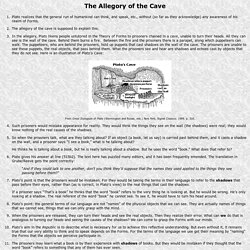

Philosophy since the Enlightenment, by Roger Jones. Philosophy since the Enlightenment, by Roger Jones. 40 Belief-Shaking Remarks From a Ruthless Nonconformist. If there’s one thing Friedrich Nietzsche did well, it’s obliterate feel-good beliefs people have about themselves.

He has been criticized for being a misanthrope, a subvert, a cynic and a pessimist, but I think these assessments are off the mark. I believe he only wanted human beings to be more honest with themselves. He did have a remarkable gift for aphorism — he once declared, “It is my ambition to say in ten sentences what others say in a whole book.” A hundred years after his death, Nietzsche retains his disturbing talent for turning a person’s worldview upside-down with one jarring remark. Even today his words remain controversial. Here are 40 unsympathetic statements from the man himself. 1. 2. 3. 4. 5. 6. 7. 8. 9. Plato of Athens - The Republic - Squashed Philosophers Abridged Edition. cDc #351: The Tao of Windows Buffer Overflow.
Ancient Greek Sacred Sites. Sacred Sites of Ancient Greece Temple of Hephaistos The Temple of Hephaestus in central Athens, Greece, is the best-preserved ancient Greek temple in the world, but is far less well-known than its illustrious neighbour, the Parthenon.

The temple is also known as the Hephaesteum or Hephaesteion. It is sometimes called the Theseum, due to a belief current in Byzantine times that the bones of the legendary Greek hero Theseus were buried there; in fact the bones alleged to be those of Theseus were buried in the 5th century BC at another site nearer to the Acropolis. The temple is located about 500m north-west of the Acropolis and about 1km due west of the modern centre of Athens, Syntagma Square. Built of marble from Mount Pentelus, in the Doric style, the temple is hexastyle, that is with six columns under the pedimented ends, and has thirteen columns on each side (counting the corner columns twice). NIHILISM by Eugene Rose. By Eugene (Fr. Seraphim) Rose [mark-up mostly done--- notes need work] Editor's Preface I. Internet Encyclopedia of Philosophy. Presocratic Philosophy. The Origins of Western Thought Philosophical Thinking Philosophy as a discipline isn't easy to define precisely.

Issuing from a sense of wonderment about life and the world, it often involves a keen interest in major questions about ourselves, our experience, and our place in the universe as a whole. But philosophy is also reflectively concerned with the methods its practitioners employ in the effort to resolve such questions. Emerging as a central feature of Western culture, philosophy is a tradition of thinking and writing about particular issues in special ways. Thus, philosophy must be regarded both as content and as activity: It considers alternative views of what is real and the development of reasons for accepting them. Since our personal growth in these matters naturally retraces the process of cultural development, study of the history of philosophy in our culture provides an excellent introduction to the discipline as a whole. Greek Philosophy Milesian Speculation Pythagorean Life. Squashed Philosophers- Condensed Plato Aristotle Augustine Descartes Hume Marx Freud Copernicus Hobbes Sartre Ayer Sade Wittgenstein Einstein.
Western Philosophy. Philosophy Timeline. Journal of Eastern Philosophy &Culture: Papers, Dictionaries, Forum, Books Reviews.
Allegory of the Cave. Plato realizes that the general run of humankind can think, and speak, etc., without (so far as they acknowledge) any awareness of his realm of Forms.

The allegory of the cave is supposed to explain this. In the allegory, Plato likens people untutored in the Theory of Forms to prisoners chained in a cave, unable to turn their heads. All they can see is the wall of the cave. Behind them burns a fire. Between the fire and the prisoners there is a parapet, along which puppeteers can walk. From Great Dialogues of Plato (Warmington and Rouse, eds.) Here are some students’ illustrations of Plato’s Cave Go back to lecture on the Phaedo Go back to lecture on the “One Over Many” Argument Go to next lecture on Criticism of Forms. Thebigview.com - Pondering the Big Questions. A&[Internet Encyclopedia of Philosophy]